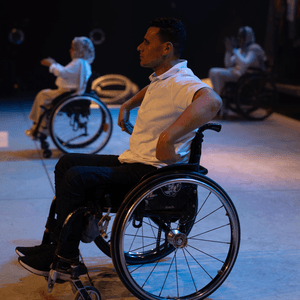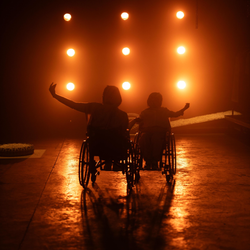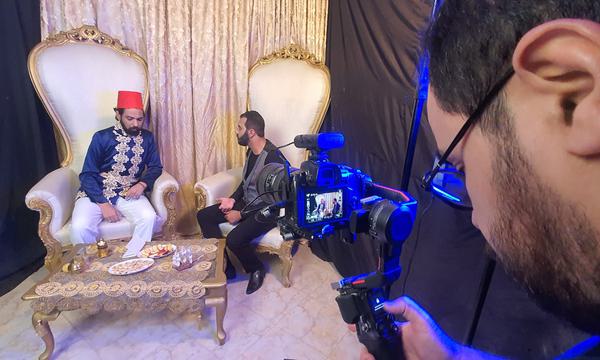News Story
We caught up with Cairo based dancers Salma Salem and Mahmoud Magdy al-Gazzar, who are collaborating with Bristol based composer Nik Rawlings on The Two Wheel Code as they prepare for the first performances of the new piece in Cairo.
The project, is is supported by the UK-Egypt creative partnership grants programme 2023 delivered by caravan at Farnham Maltings and Orient Productions, and supported by British Council Egypt, Arts Council England and Fonds de Soutien aux Arts Arabes (FSAA).
The Two Wheel Code tells the story of three characters who use wheelchairs in Cairo, presenting the choreography of their daily lives while negotiating the urban architecture of the city. The project explores a journey of movement research on wheels, creating a new performance and integrating the sounds of the participants and of Cairo itself into the soundtrack for the work. The collaboration brings together movement score from Egypt and sound score from the UK and hopes to challenge the idea of “disability”.
The project has been developed remotely, with Salma and Mahmoud working on the choreography and undertaking the workshops and rehearsals in Cairo and collaborating with Nik online to compose the music for the performance in response.
How did you first connect?
S: I connected with Mahmoud some time ago as we both attended a few workshops together. With Nik, we were introduced through a common friend and colleague… We met online, and we instantly had a nice flow of conversation.
M: I didn't know Nik, but I heard a lot about them from Salma. Nik is talented and has the ability to make music suitable for every situation.
Why did you choose the landscape of Cairo as the backdrop for this piece?
S: Because Cairo is where myself and Mahmoud live. It is not exactly an accessible environment for wheelchair users, so it inspires a whole new meaning of adaptation.
M: Cairo is the capital of Egypt and it is one of the most beautiful places in the Arab world.
Can you share more about how the choreography and composition are being developed for the performance piece?
S: The choreography and composition are being developed in a few ways. Firstly, we have had many conversations in search of content, and then we explore movements that best describe what was discussed. We have also been doing some collective reading of a book written by Gary Karp called “Life on Wheels”. We work on a bit of improvisation in terms of dynamic movements in space for self-expression, as well as the static fixed movements with the upper limbs. We explore concepts of coordination and moving as a collective, as well as singularity. The dancers all have different ranges of movements in terms of rotations and extensions, they all have different limitations in their bodies, so we find ways around those limitations for singular expression, and at other times we try to find the middle ground for the movement in order to increase the bond as a collective.

What are you learning from the remote exchange and the rehearsal process?
S: In rehearsals, I’m learning a lot about the dancers' bodies and how they like to move - what feels good and what does not. I am learning a lot from Mahmoud, Bassant and May about their daily struggles. I learned that I myself could also learn a lot about awareness from our conversations. I learnt to prioritise the process rather than the performance. What matters most to me is seeing the happiness on their faces after we finish a rehearsal session.
From the remote exchange, I'm learning a lot about trust and patience. I'm gaining some insights into problem solving skills. It is really good to talk to Nik about the challenges throughout each step of the way. So far there has been a very nice and sincere working chemistry between us. We, I think both share a similar dream... of the team and I being able to go to the UK and have Nik join us live.
M: Through the project I learned a lot about challenging ideas that are associated with disability. First, getting to know the body’s joints, the movement the body needs, and flexibility through training and expressing everything that is within us.
I hope to participate in more projects on the development of choreography and composition for performance pieces in collaboration with Salma and Nik. I have learnt a lot from the remote exchange, but the biggest benefit is the training process. It helped me get out of depression and gives me positive energy.
Through the project you are hoping to challenge ideas around disability. What would you like audiences to take away from The Two Wheel Code?
S: We already know that Cairo is not an accessible environment, but to hear it from the dancers' participating in our project and seeing it expressed by them is what matters most. We hope to bring awareness to the power of labels and shifting focus from the use of the word “disability” to “differently abled”. We would like people to become more aware that when deciding to help someone who is differently abled, they need to ask “how” they could help rather than just jump in for the rescue without really listening. We would like people to realise that we can adapt to the needs of the differently abled and that most differently abled individuals cannot adapt to our standards, like for example the placement and height of light switches, the “correct” measurements of ramps in Cairo that make life easier and not actually more hazardous to the wheelchair user community. We would like to raise more awareness for empathy and not sympathy… We would like to raise awareness about the fact that the wheelchair is regarded as personal space and is a part of the body.
M: We would like the audiences to look at us in a positive light and see that we are capable and heroes, but in our own ways.

...and what will you each be taking away from the collaboration?
S: A beautiful process, a genuine development of trust and respect. Managing expectations and a whole lot of patience. Also to trust that the process is more valuable than the output… and about how to really listen to one another.
M: Benefiting from collaboration is the greatest takeaway and motivation for us in terms of prospective outlook, the work, and expression of what is inside us. Collaboration also helps us in taking out all the negative energy inside of us and turning it into positive energy.




